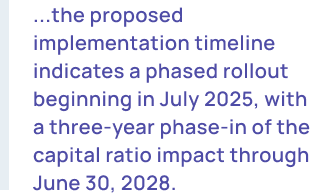
Banks across the United States are already facing a more stringent regulatory environment. For many, the pressure to maintain strong capital positions has intensified in recent years, driven by shifts in market risk, deposit volatility, and supervisory scrutiny.
Larger U.S. banks, particularly those with assets exceeding $100 billion, are preparing for new capital requirements under the proposed Basel III Endgame. While these reforms primarily apply to the largest institutions, the conversation around capital planning, funding diversity, and portfolio risk is also increasingly relevant for regional and mid-sized banks.
In a time of economic ambiguity and rising regulatory expectations, bank leaders are facing harder choices with tighter margins. The Basel III Endgame isn’t just a capital rewrite—it’s a test of how well an organization aligns risk, liquidity, and client service in a cost-pressured world. At R&T, we see this moment not as a compliance burden, but as an opportunity to help our clients strengthen resilience while preserving client-centric value.
What Is The Basel III Endgame?

The Basel III Endgame proposal, released in 2023, aims to raise the bar on capital adequacy by revising the amount of capital banks must hold and how risk is measured. These reforms could have implications for lending capacity, balance sheet strategy, and risk-based capital buffers. Basel III Endgame represents the final step in the evolution of the Basel Accords. Proposed by U.S. banking regulators to align with the Basel Committee’s 2017 recommendations, these changes aim to standardize how banks measure credit, market, and operational risk, particularly by reducing reliance on internal models and shifting toward standardized approaches.
Read the whitepaper here: https://www.fdic.gov/system/files/2024-06/2023-regulatory-capital-rule-large-banking-organizations-3064-af29-c-306.pdf
What the Basel III Endgame Could Mean for Capital Requirements
Several technical revisions that could meaningfully shift how banks calculate and ultimately hold capital are at the core of the Basel III Endgame proposal. The full impact of these changes will vary widely by institution. The proposals could introduce additional pressure on strategic planning, lending capacity, and return on equity for banks with lean capital positions or heavier exposure in higher-risk categories.
While nothing is final, the direction is clear: capital will be more scrutinized, and banks with limited room to maneuver may need to begin evaluating how to adapt.
While Basel III Endgame’s most direct impact will be felt by the largest U.S. banks, its influence is already shaping the strategic priorities of community and regional institutions. As regulatory expectations evolve and market participants seek stability, banks of all sizes are reassessing their funding strategies, risk management practices, and capital planning frameworks. This sector-wide shift reflects not only the letter of new rules, but also the broader spirit of resilience and transparency that regulators and customers now demand.
For banks with brokered deposits, sweep, or reciprocal funding strategies, understanding the downstream impact on balance sheet treatment and capital planning is now critical.
Basel III Endgame Implementation Timing and Regulatory Uncertainty

U.S. regulators introduced the rulemaking in mid-2023, and the proposed implementation timeline indicates a phased rollout beginning in July 2025, with a three-year phase-in of the capital ratio impact through June 30, 2028.
The proposals have raised questions about how they may affect institutions with concentrated portfolios, long-duration assets, or limited ability to raise additional capital.
For banks, this uncertainty creates a strategic challenge. Waiting for final rules may delay preparation, but acting too early may lead to misaligned planning. As a result, many institutions are choosing to scenario plan and evaluate the potential effects of the current proposal while remaining ready to adjust as new information becomes available.
Funding Strategy in a Capital-Conscious Environment
As banks assess the potential implications of the Basel III Endgame proposals, many are revisiting their broader funding strategy. While the proposed rules do not prescribe specific funding types, they are part of a growing trend that emphasizes stability, transparency, and risk management.
Core-like, fully insured deposits have long been considered a reliable source of funding. In an environment where capital calculations are increasingly sensitive to asset risk and liquidity structure, these deposit types play a more significant role in strategic discussions.
Some institutions are exploring ways to reduce reliance on more volatile or short-term wholesale funding by diversifying into insured sweeps or other customer-focused solutions. While these products are not a regulatory requirement, they may help support a stronger overall funding profile that can better withstand periods of uncertainty.
Ultimately, the objective for many banks is not just compliance but confidence. A thoughtful, stable funding mix can support more consistent planning, particularly in a changing capital framework.
How R&T’s Solutions Help Banks Diversify and Strengthen Funding
R&T supports a broad network of financial institutions navigating diverse regulatory landscapes. Our approach is grounded in three core commitments:
-
Safety and soundness: Ensuring deposit solutions meet regulatory expectations and withstand supervisory scrutiny.
-
Transparency and trust: acting as an honest broker who shares insights candidly and aligns with risk-mitigation goals.
-
Customized strategies: tailoring deposit and liquidity structures to each client’s balance sheet and business model.
R&T Deposit Solutions offers banks access to tools that support stable, insured funding, an area of growing focus as institutions adapt to evolving regulatory proposals and market conditions.
Through programs administered by R&T, banks can offer reciprocal deposit and insured cash sweep services that help retain large-dollar customer relationships while enabling access to expanded FDIC insurance coverage across participating institutions. These programs are designed to help banks diversify funding, reduce reliance on less predictable sources, and provide customers with peace of mind regarding deposit protection.
R&T does not position these solutions as a response to specific regulations but as part of a broader strategy to enhance deposit stability and operational resilience. The programs include features that promote transparency, control, and ease of reporting, helping institutions integrate these tools into their daily treasury and funding operations.
In an environment where capital and liquidity planning are under greater scrutiny, access to dependable, insured deposits may offer banks a meaningful way to strengthen their funding foundation.
Planning Ahead with Confidence
The Basel III Endgame proposals represent a pivotal evolution in global capital standards. While the final form and timing remain uncertain, banks that act now will be best positioned to adapt with agility and confidence.
Here are actionable steps and key questions to guide your planning:
-
1
Conduct a Basel III impact assessment
Have we mapped the proposed changes to our current capital, funding, and risk frameworks? Which business lines or portfolios are most exposed to RWA inflation or new capital buffers?
-
2
Develop scenario plans and stress tests
Are we running scenario analyses that incorporate both the proposed and potential final rules? Do our stress tests accurately capture the expected volatility in capital ratios during the phase-in period? What early warning indicators can we monitor to detect regulatory or market shifts?
-
3
Review and diversify funding strategies
How resilient are our funding sources under stressed regulatory and market environments? Are we optimizing our deposit mix for stability, including fully insured and reciprocal programs?
-
4
Enhance risk management and governance
Are our risk management frameworks and IT systems prepared for new standardized approaches and reporting requirements? Do we have clear ownership and escalation protocols for regulatory updates and scenario outcomes?
-
5
Engage stakeholders and communicate proactively
Are we aligning messaging and strategy across risk, finance, treasury, and executive leadership? How are we preparing our board and frontline teams for potential changes and supervisory questions?
By embedding these steps into your planning cycle, your institution can transition from reactive compliance to proactive resilience, leveraging regulatory change as a strategic advantage.
We know many clients are still working through what “material exposure” means for their operations, and how best to align Basel changes with their funding stack. R&T will continue to monitor the rulemaking process and share guidance as we do.
As always, our goal is to be a sounding board and strategic partner. If you’d like to explore how we can support your Basel readiness, specifically through our funding strategies, contact an expert at R&T. Let’s navigate this next chapter together.